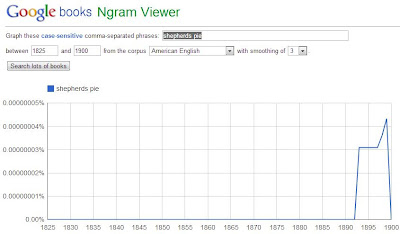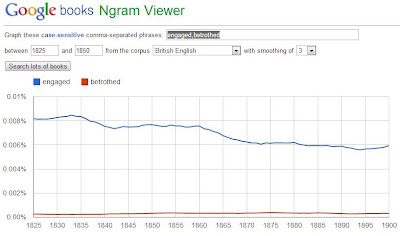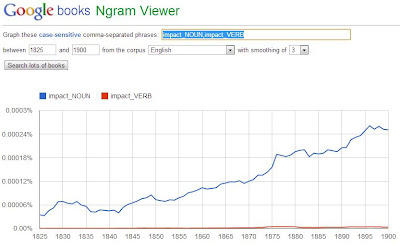When I wrote my previous novel, Counter Currents, and while I write its sequel, I often stop to check if words I use are true to the era in which I set the story. I feel I must do more than engage and entertain my readers: I must not misinform.
Most important to me are the verbs and nouns I choose for narration and conversation. I strive to make sure those words were part of the common vernacular in the story’s era.
Sound difficult? Not so much!
Thanks to the benevolent geeks at Google, there is an app for that. It’s called Google Books Ngram Viewer. In 2009 and 2012, Google created databases of words in all its digitized books, and organized those words by the year of publication.
To use it, simply enter the case-sensitive word or phrase to search for, set a year-range, select the corpus and click the search button. Ngram Viewer returns a graph of the usage as a percentage of words in the selected corpus.
Here are a few examples of how I used Ngram Viewer to improve the historical accuracy of my novels.
In my 2012 novel Counter Currents, set in 1838 North America, I wanted to serve the protagonist a lunch of shepherd’s pie. So, I entered the food name, set the time span from 1825 to 1900, and picked the American English corpus. (I used a 75-year range to learn when the term came into use if outside of my story’s era.)
The result shows that shepherd’s pie did not appear in books until about 55 years later, and even then, rarely. This technique is handy for verifying food, clothing, people’s names, and manufactured items.
Ngram Viewer can also help with regional dialect. In my current sequel to Counter Currents, set in 1845-1855 Australia, I want to include some Aussie slang. I entered “billabong” (a term for a type of creek) in Ngram Viewer. No luck. That word doesn’t appear until after 1880.
The Ngram Viewer also lets you use the best word if several are available. In my sequel, my protagonist agrees to get married. Which is the best word: “engaged” or “betrothed”? I used the British English corpus as the most likely to reflect nineteenth century Australian English.
To graph more than one search term, separate each with a comma.
This graph shows that both words are valid but books used “engaged” more often in that era.
In English, you can use just about any noun as a verb. Before you do, make sure the spoken language in your historical era used that verb form?
Ngram Viewer can graph the same word used as different parts of speech. You just add one of the many available tags to your search terms. (Click the About Ngram Viewer link at the bottom of the Ngram page for details on the many tags and other advanced features.)
In this example, I add the tags _NOUN and _VERB to the word “impact.”
This graph shows that books did not include “impact” as a verb until the 1870s, and very rarely compared to the noun form.
The corpus list provides several choices for English books—all English books, British English for books printed in the UK, American English for books published in the US, and just English fiction books—plus seven other languages. (Use the 2012 versions without the dates, not the 2009 versions: the 2012 scans contain fewer spelling errors.)
Pick the English corpus that suits your geographical location to help refine your word selection. For example, Ngram Viewer shows that American books used the word “boss” as a noun sporadically in the eighteenth century, but English books used it throughout that period. (I entered “boss_NOUN” in two separate searches using a different corpus.)
If a word sounds like slang, or inner doubts nag me (always trust your intuition) or I are faced with several synonyms, I use Ngram Viewer. It takes just seconds.
Most important to me are the verbs and nouns I choose for narration and conversation. I strive to make sure those words were part of the common vernacular in the story’s era.
Sound difficult? Not so much!
Thanks to the benevolent geeks at Google, there is an app for that. It’s called Google Books Ngram Viewer. In 2009 and 2012, Google created databases of words in all its digitized books, and organized those words by the year of publication.
To use it, simply enter the case-sensitive word or phrase to search for, set a year-range, select the corpus and click the search button. Ngram Viewer returns a graph of the usage as a percentage of words in the selected corpus.
Here are a few examples of how I used Ngram Viewer to improve the historical accuracy of my novels.
In my 2012 novel Counter Currents, set in 1838 North America, I wanted to serve the protagonist a lunch of shepherd’s pie. So, I entered the food name, set the time span from 1825 to 1900, and picked the American English corpus. (I used a 75-year range to learn when the term came into use if outside of my story’s era.)
The result shows that shepherd’s pie did not appear in books until about 55 years later, and even then, rarely. This technique is handy for verifying food, clothing, people’s names, and manufactured items.
Ngram Viewer can also help with regional dialect. In my current sequel to Counter Currents, set in 1845-1855 Australia, I want to include some Aussie slang. I entered “billabong” (a term for a type of creek) in Ngram Viewer. No luck. That word doesn’t appear until after 1880.
The Ngram Viewer also lets you use the best word if several are available. In my sequel, my protagonist agrees to get married. Which is the best word: “engaged” or “betrothed”? I used the British English corpus as the most likely to reflect nineteenth century Australian English.
To graph more than one search term, separate each with a comma.
This graph shows that both words are valid but books used “engaged” more often in that era.
In English, you can use just about any noun as a verb. Before you do, make sure the spoken language in your historical era used that verb form?
Ngram Viewer can graph the same word used as different parts of speech. You just add one of the many available tags to your search terms. (Click the About Ngram Viewer link at the bottom of the Ngram page for details on the many tags and other advanced features.)
In this example, I add the tags _NOUN and _VERB to the word “impact.”
This graph shows that books did not include “impact” as a verb until the 1870s, and very rarely compared to the noun form.
The corpus list provides several choices for English books—all English books, British English for books printed in the UK, American English for books published in the US, and just English fiction books—plus seven other languages. (Use the 2012 versions without the dates, not the 2009 versions: the 2012 scans contain fewer spelling errors.)
Pick the English corpus that suits your geographical location to help refine your word selection. For example, Ngram Viewer shows that American books used the word “boss” as a noun sporadically in the eighteenth century, but English books used it throughout that period. (I entered “boss_NOUN” in two separate searches using a different corpus.)
If a word sounds like slang, or inner doubts nag me (always trust your intuition) or I are faced with several synonyms, I use Ngram Viewer. It takes just seconds.




No comments:
Post a Comment